Brewing first beer this week...
Brewing first beer this week...
-
-
-
-
-
Brewing first beer this week...
-
Post #1 - August 11th, 2010, 1:38 pmAnyone have any general brew-virgin advice? The cardinal "don'ts"?
I've skimmed a book, watched a DVD....figured LTH is always the best place to come for the advice, tips, and tricks of the people who have learned through experience.
-
-
Post #2 - August 11th, 2010, 1:41 pmYou can't be too anal about cleanliness and sanitation.Objects in mirror appear to be losing.
-
-
Post #3 - August 11th, 2010, 3:04 pmWhat he said. Are you going extract or all-grain?
-
-
Post #4 - August 11th, 2010, 3:14 pmcongratulations on making the leap into craft beer!
good advice - keep it clean, take it slow.
If you have specific beer brewing questions, the Chicago Beer Society email list is also a great resource. You can sign up for the list on their website (chibeer.org). Once you sign up for the email list, you can post questions to the whole list of subscribers
-
-
Post #5 - August 11th, 2010, 3:29 pmnr706 wrote:What he said. Are you going extract or all-grain?
Word. Seems like a lot of info in forums, books, etc are saying that solely with extremely diligent sanitation/cleaning that i'll be hard pressed to completely screw it up. Extract, btw. Figured we could jump into the shallow end before going in over my head right off the bat.jannamae008 wrote:congratulations on making the leap into craft beer!
Thank you. I'm pretty excited about.jannamae008 wrote:good advice - keep it clean, take it slow.
If you have specific beer brewing questions, the Chicago Beer Society email list is also a great resource. You can sign up for the list on their website (chibeer.org). Once you sign up for the email list, you can post questions to the whole list of subscribers
Much appreciated, I think i'll jump on that. I'll be sure to take pictures and post up results, this should be pretty fun.
-
-
Post #6 - August 11th, 2010, 3:35 pmAs others have noted, sanitation & cleanliness is very important. You might get away with cutting some corners before the boil but not so much after. If using a chlorine bleach sanitizer, be sure to rinse everything with clean, filtered (or boiled) water to get rid of the chlorine. It will make the beer taste/smell like Band-Aids or Chloroseptic. I prefer a no-rinse sanitizer such as Iodophor or StarSan. They don't hurt stainless steel like chlorine can, have shorter contact times for the same result, and don't require rinsing.
For safety, if you have glass carboys with a handle around the neck, don't use the handle for anything other than steadying it when full. Also be careful of glass carboys full or empty when wet. Those babies are slippery.
As jannamae008 mentioned, the folks on the Chicago Beer Society list server can also provide answers to pretty much any question. I am a little biased though as I'm one of the club's board members.
-
-
Post #7 - August 11th, 2010, 3:44 pmjpreiser wrote:
For safety, if you have glass carboys with a handle around the neck, don't use the handle for anything other than steadying it when full. Also be careful of glass carboys full or empty when wet. Those babies are slippery.
All good advice - though I must say in all the years of using glass carboys with the handle I never had a problem. My favorite part of the glass vessel was watching the fermentation. I found it extremely relaxing to sit in my apartment and just watch the beer bubble away in there - like TV but without the side effects.Objects in mirror appear to be losing.
-
-
Post #8 - August 11th, 2010, 4:00 pmI have a stout going now, and I agree ... the blurping sounds from the airlock are one of the world's nicest sounds. But I've switched from glass carboys to the immodestly-named Better Bottles - they're much lighter and virtually unbreakable.
-
-
Post #9 - August 11th, 2010, 4:28 pmWith extract brewing, be sure to stir the liquid malt extract (LME) in well. If you get a lump at the bottom, it can scorch. If that happens, you'll have made a nice rendition of Southern Tier's Creme Brulee.
Seconds on the Iodophor/StarSan. General cleanliness is important, but anything the wort touches post-boil must be immaculate. If not, you can call it a Saison.
And now for a question that, oddly enough, no one has asked yet: what kind of beer are you making?
-
-
Post #10 - August 11th, 2010, 5:03 pmIrish Stout. Or, depending on how it goes, something that may distantly resemble an Irish Stout.
I bought the kit from Midwest Homebrewing and Winemaking Supplies, they put the whole thing together themselves which - from what i've heard - means that it should be relatively reliable as it's a home brewing store's in-house package. (?)
The package lists exactly this:
Fermantables: 6 lbs Dark LME
Specialty Grains: 4oz Chocolate Malt, 4 oz Caramel 10L, 4 oz Roasted Barley, 4 oz Flaked Barley (pre-mixed)
Hops: 1/2 oz Nugget, 1 oz Wilamette
Also Included: 1 tsp Gypsum, priming sugar, muslin bag, and dry yeast
--OR--
Liquid Yeast Option Wyeast Irish Ale #1084 or White Labs Irish Ale #WL004
It'll be interesting when I'm kind of wondering what a good number of those things are
-
-
Post #11 - August 11th, 2010, 5:20 pmI get all my stuff from Midwest Supplies. I don't do their kits (although they're well-known for them). The kit looks a little light on hops, and depending on your water source, you may not need the gypsum, but the addition of as little as 1/4 tsp of table salt (non-iodized) can contribute to mouthfeel.
Which of the ingredients are you wondering about?
If it doesn't come out like a stout as you envision, you can always call it a porter ... there's no strict definition of what a porter is.
-
-
Post #12 - August 11th, 2010, 9:54 pmThe only advice I have is relax, have a homebrew!
Honestly, the beer pretty much takes care of itself. Just follow the instructions in the kit, sanitize everything, and you'll be fine. It takes some effort to eff up a beer. (But I have managed to do it.) The main points are sanitation (and even here the beer can be more resilient than you'd think) and don't pitch the yeast in wort that hasn't cooled down (you may kill the yeast this way.) Also, once the fermenting has started, you want to minimize the contact of the beer with oxygen, lest you get a wet-cardboard-like flavor into it. The warmer the fermentation temp, the more yeasty flavors you'll get. So, you generally want to keep it under 72F. 66-68F is the general range I shoot for in ales, although I may push it up to 70F.
But just trust for it to work. I remember how nervous I was the first beer I made. It took a good 24-36 hours for me to get any airlock activity. I thought I had screwed up (and most my beers these days take off in 12-18 hours), but it just happened to be a slow start, for whatever reason. Once it took hold, it took off and fermented out in about three or four days. And it was delicious. Still one of my favorite brews.
-
-
Post #13 - August 11th, 2010, 11:59 pmnr706 wrote:The kit looks a little light on hops, and depending on your water source, you may not need the gypsum, but the addition of as little as 1/4 tsp of table salt (non-iodized) can contribute to mouthfeel.
Which of the ingredients are you wondering about?
Well, i suppose looking at it I'm only really wondering why I have a few yeast options and what that decision will entail for the final product.
What do you know about the yeast that's in that kit?
As for the water source - I've read that that is a factor for people - but Chicago's tap water is pretty awesome, no? At least at my place I haven't experienced any off tastes or anything and water from my sink is probably what I consume the most of at home. I feel like at this juncture I shouldn't sweat it too much.
1/4 tsp of salt? Done. love salt, 1/4 tsp can't hurt i would imagine.
I guess my last question before I really start over-thinking this is: my basement sits at a really cool like 65 degrees - too cold?
-
-
Post #14 - August 12th, 2010, 1:39 amdjenks wrote:I guess my last question before I really start over-thinking this is: my basement sits at a really cool like 65 degrees - too cold?
Perfect for an ale.
-
-
Post #15 - August 12th, 2010, 9:50 amnr706 wrote:djenks wrote:I guess my last question before I really start over-thinking this is: my basement sits at a really cool like 65 degrees - too cold?
Perfect for an ale.
Yeah, the ideal temperature range for the Wyeast 1084 Irish Ale yeast you're talking about using (and with which I have made plenty a fine beer) is 62-75 degrees Fahrenheit.Ronnie said I should probably tell you guys about my website so
Hey I have a website.
http://www.sandwichtribunal.com
-
-
Post #16 - August 12th, 2010, 5:41 pmKman wrote:
My favorite part of the glass vessel was watching the fermentation. I found it extremely relaxing to sit in my apartment and just watch the beer bubble away in there - like TV but without the side effects.
Not good advice for a newby. If you are watching it, the beer is getting "light struck" and picking up skunky qualities.
Ron
-
-
Post #17 - August 12th, 2010, 9:02 pmI have never had any issues with beer becoming light-struck in primary fermentation. Granted, I don't keep it in direct sunlight, but I don't cover it up, either. When I transfer to the secondary, that's when I throw a dark shirt or something over it. Haven't noticed any skunking.
-
-
Post #18 - August 13th, 2010, 8:25 amI agree - I wouldn't worry about skunkiness in the primary. Presumably the light in the room isn't that bright, and dark beers are much less susceptible to skunkiness anyway (the dark color of the wort protects the bulk of the beer just as the brown color in beer bottles does).
-
-
Post #19 - August 13th, 2010, 9:06 amChicago/Lake Michigan water is a good source for brewing. If you ever switch to all-grain brewing, you may want to make some minor adjustments depending on what you're brewing but a carbon filter to remove the chlorine should be fine for extract brewing.
As to your yeast options, I'd recommend going with one of the liquid choices. I'm partial to Wyeast at the moment but have used White Labs with success in the past. The primary differences between dry and liquid yeast packaging are viability and selection. The companies that produce dry yeast don't have as wide a selection as the liquid companies. This may not matter if you're looking for a fairly neutral ale yeast but becomes critical if looking for specialty (saison, lambic, Bavarian wheat, etc.). The other issue is ensuring the packet has enough viable yeast cells to properly ferment the batch. Most often, without a starter, dry yeast is lacking enough yeast and fermentation issues can occur. Liquid yeast, presuming it's not beyond its use-by date, can be used without a starter on low-to-medium strength beers.
The major difference between Wyeast and White Labs is packaging.
White Labs ships vials containing a batch's worth of yeast in a slurry. You take the vial out of the fridge a 1/2 hour or so before brewing so it can warm up. When ready to add to the fermenter, the vial is shaken to mix everything up, carefully opened (or you'll get a bath), and the contents added.
Wyeast uses a smack pack containing a small amount of yeast and an inner nutrient pack. Before brewing you break the inner pack and mix the two parts together which causes the yeast to wake up, multiply, and start fermenting the nutrient soup. You know the yeast is ready when the pack is puffed up like a firm pillow. When it's time to add yeast, sanitize the pack and a pair of scissors, shake up the pack to mix thing up, cut a small corner off the pack, and add the contents sans inner pack to the fermenter.
-
-
Post #20 - August 13th, 2010, 11:03 amRonJS wrote:Kman wrote:
My favorite part of the glass vessel was watching the fermentation. I found it extremely relaxing to sit in my apartment and just watch the beer bubble away in there - like TV but without the side effects.
Not good advice for a newby. If you are watching it, the beer is getting "light struck" and picking up skunky qualities.
Ron
Light in that apartment? LOL.Objects in mirror appear to be losing.
-
-
Post #21 - August 16th, 2010, 11:26 amAlso, skunking comes from light-struck isomerized hops acids, and given the hop amounts on this, it can't possibly be strong.
That said, how'd the brew day turn out?
-
-
Post #22 - August 16th, 2010, 12:57 pm...not till tomorrow. Ended up not being able to do it Saturday, next day off is tomorrow (Tues.)
I'll have pics and the whole process up when I do, promise.
-
-
Post #23 - August 17th, 2010, 5:08 pm...currently 35 minutes into the boil.
Steeped the grain bag for 23 minutes at 160 degrees, removed it, added LME, gypsum, and 1/4 tsp of kosher salt made sure it was fully dissolved and then started boiling.
Once boiling, i've added .54 oz of Nugget pellet hops. 35 minutes in so far and that brings us to now.
Post back up with pics when we're done. thanks for the advice so far guys
Dave
-
-
Post #24 - August 17th, 2010, 6:48 pmWe potentially messed this up bad. But whatever, we're not sweating it, i'll get to that in a second.
Started off with steeping grains. Well, actually, we started off cleaning everything, then while the grains were steeping we cleaned everything again. I don't know how anal cleanliness needs to be in practice, but I think i've gotten the point based on all the advice i've heard.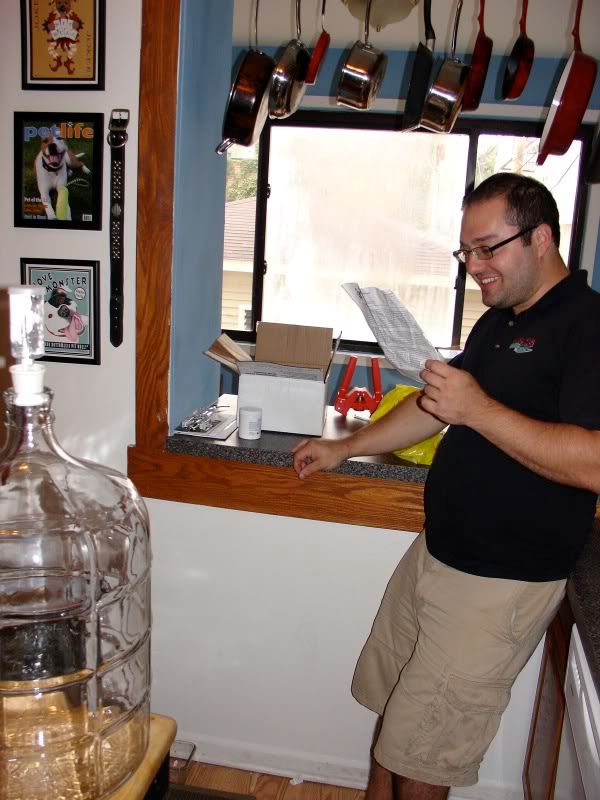
My buddy Slices trying to figure out what the hell we're doing.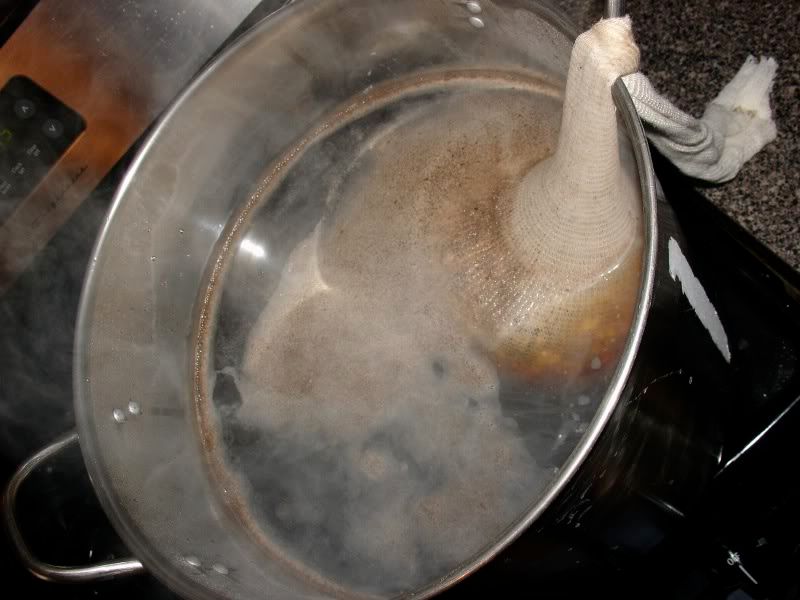
Steeping grain. We were able to keep it at 160 degrees pretty consistently for 23 minutes. why 23? who knows thats just how long we decided to set the timer. Most of the steeping process we kept the pot covered.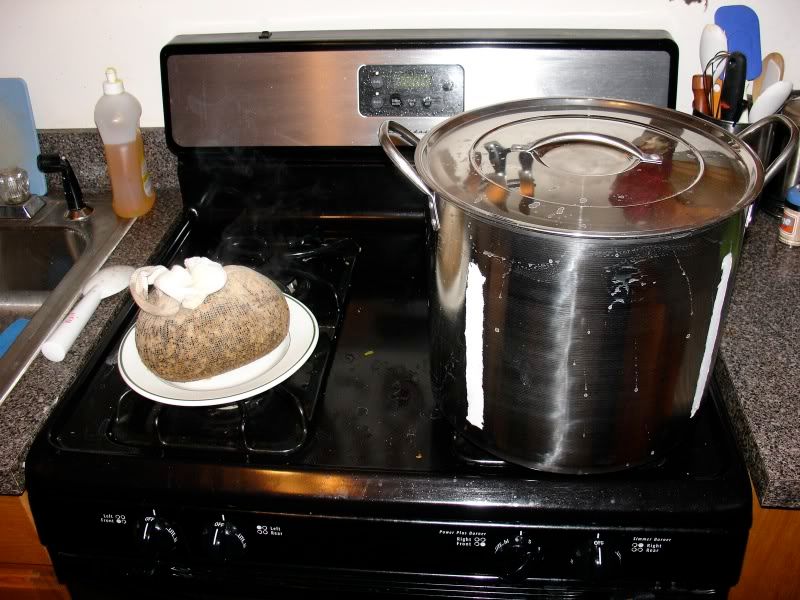
Grain removed
Initial wort before LME was added
Adding LME, gypsum and 1/4 tsp kosher salt. Waited for it fully dissolve...nothing to burn or stick to the bottom of the pot.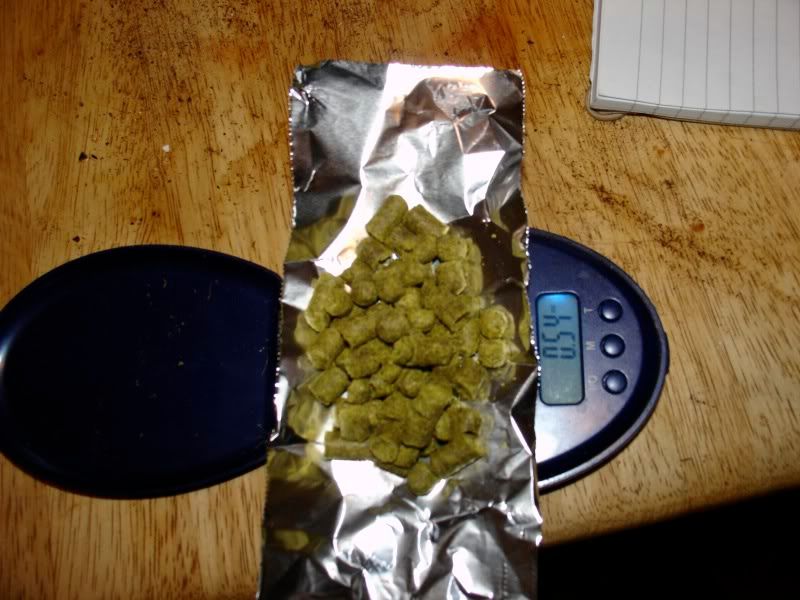
Weighing hops...added .54 oz of Nugett pellet hops. Boiled that for 60 minutes
(also added 1 oz Willamette, boiled that for about 2-3 minutes)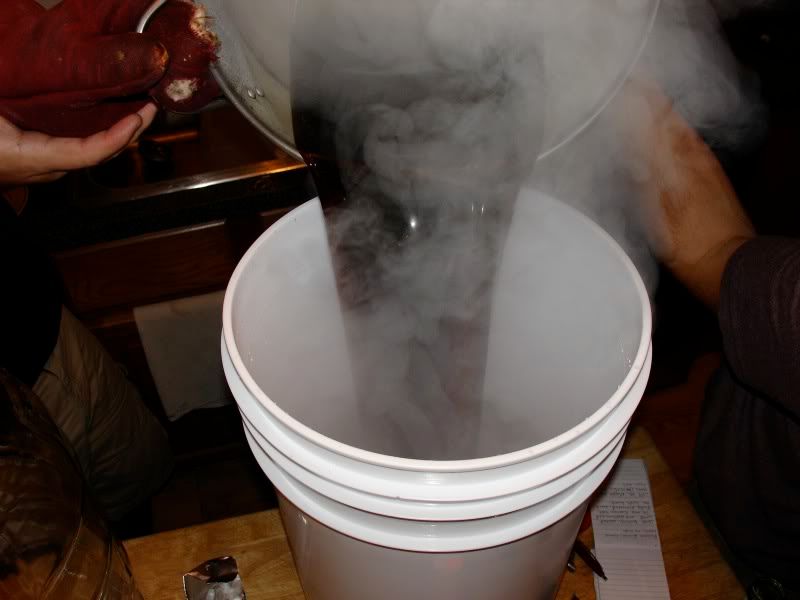
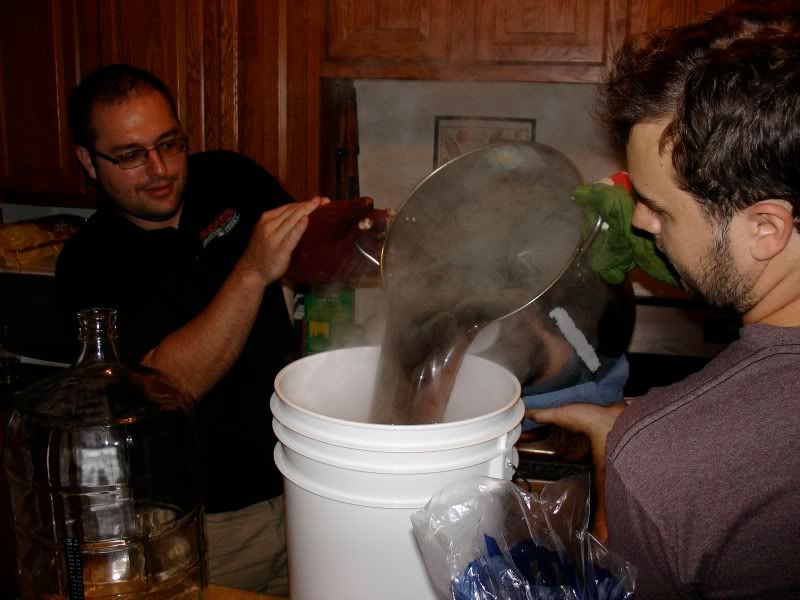
Pouring into the first fermentor. This is where we may have messed up. Our kitchen sink doesn't have enough room to quickly cool the wort in a nice ice bath. So, we decided to go with option #2 listed on our instructions (#3 being a wort chiller which i don't have) which is to add ice to your wort for your final two gallons of water. It worked nicely - within a minute we were down to about 100 degrees F. We pitched the dry yeast to a 100 degree wort as we're reading that you should never use commercial ice as it's not guaranteed to be clean. Shit. Oh well. Guess we just have to hope there is no contamination.
Either way - we've got our wort, with our yeast pitched at 100 degrees, sealed up with the airlock half filled with water in a dark, 65 degree area. I guess all we can do is wait at this point.
Saturday night we should transfer this to our glass carboy and then let that sit for a couple weeks no?
Thanks for all the advice...even if it comes out less than ideal i think we at least have the general idea down. While this is sitting around i guess we're just going to continue reading about everything we did wrong
-
-
Post #25 - August 17th, 2010, 9:03 pmdjenks wrote:. We pitched the dry yeast to a 100 degree wort as we're reading that you should never use commercial ice as it's not guaranteed to be clean. Shit. Oh well. Guess we just have to hope there is no contamination.
Chances are you'll be fine. I personally wouldn't worry about it.Either way - we've got our wort, with our yeast pitched at 100 degrees, sealed up with the airlock half filled with water in a dark, 65 degree area. I guess all we can do is wait at this point.
Now this might cause me some concern. A 100-degree wort is still a bit hot for pitching your yeast. Did the instructions say to pitch to this temperature? I wouldn't pitch at anything higher than 85 degrees. Most sources even think that's a tad high and recommend the 70-80 degree range. You're risking killing all your yeast at 100F, but you may still be okay (I've never personally tested this out, this is just the general beer brewing wisdom.) If you don't see any fermenting activity in 48 hours or so, I'd pitch another batch of yeast.
-
-
Post #26 - August 17th, 2010, 9:41 pmInteresting.
Our "brewing yeast" said that it needed to either be started in water or wort that was between 35-40 C. So we kinda thought we were in the clear there.
Hypothetically, if i do notice no activity in 48 hours, how should i go about recovering the brew? I would imagine that i would activate another batch of yeast in proper temperature water and then just add that in, no?
Thanks again
Dave
-
-
Post #27 - August 17th, 2010, 9:54 pmWhat was the size of the yeast packet? Some are in the 6 - 7 gram range; others are 10 - -12 grams. In general, it's hard to add too much yeast, but if it was one of the smaller packets, any nasties that may have been on the ice (or elsewhere) might have slightly more of a chance to get a foothold. I'd re-pitch if there's no activity after about 36 hours, but that's just me.
-
-
Post #28 - August 18th, 2010, 9:43 amdjenks wrote:Our "brewing yeast" said that it needed to either be started in water or wort that was between 35-40 C. So we kinda thought we were in the clear there.
Huh. That is interesting. If the brewing yeast packet says 35-40C, then I would think they know what they're talking about. I've never seen brewing yeast start this high, but I know that bread yeasts don't begin to die off until about 50C (hence my hedge about you possibly being okay and that I've never tested it out before.)
A lot of brewers still recommend pitching at closer to fermentation temps, claiming there's less ester and fusel off-flavors. These flavors are produced at higher fermentation temperatures. I personally don't think there would be that much fermentation at these higher temps, and by the time the yeast fully takes hold, your wort would have settled down to room temperature. I do personally notice more yeastiness when I ferment at, say, 72 instead of 65, but that's five days at this temperature, not a few hours (as your wort cools down.) For a stout, I don't think any off flavors you might develop in that time period would be noticeable, but in a lager or otherwise clean-tasting beer, it could be.
-
-
Post #29 - August 18th, 2010, 3:30 pmI've only done the mac-n-cheese method so far (heat, pour and stir) but am interested in trying the full process this year -- but can I do it if my kitchen doesn't have a hood over the stove? That might be a silly question, but for some reason I was under the impression that the long boil is best done where the steam or whatever can escape into fresh air.pizza fun
-
-
Post #30 - August 18th, 2010, 4:27 pmI have a boil going on right now. Not the greatest vent system, but with windows open, no problem. After all, who doesn't want to around hot steamy kettles mid-summer?
At least in winter, the steam provides a whole-house facial.

